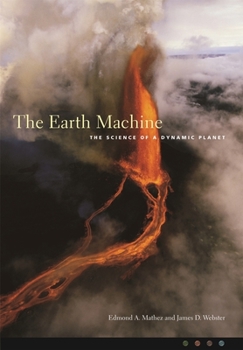The Earth Machine: The Science of a Dynamic Planet
Select Format
Select Condition 
Book Overview
From the scorching center of Earth's core to the outer limits of its atmosphere, from the gradual process of erosion that carved the Grand Canyon to the earth-shaking fury of volcanoes and earthquakes, this fascinating book--inspired by the award-winning Hall of Planet Earth at New York City's American Museum of Natural History--tells the story of the evolution of our planet and of the science that makes it work. With the same exuberance and expertise they brought to the creation of the Hall of Planet Earth, co-curators Edmond A. Mathez and James D. Webster offer a guided tour of Earth's dynamic, 4.6-billion-year history. Including numerous full-color photographs of the innovative exhibit and helpful, easy-to-understand illustrations, the authors explore the major factors in our planet's evolution: how Earth emerged from the swirling dusts of a nascent solar system; how an oxygen-rich, life-sustaining atmosphere developed; how continents, mountain ranges, and oceans formed; and how earthquakes and volcanic eruptions alter Earth's surface. Traversing geologic time and delving into the depths of the planet---beginning with meteorites containing minuscule particles that are the solar system's oldest known objects, and concluding with the unusual microbial life that lives on the chemical and thermal energy produced by sulfide vents in the ocean floor-- The Earth Machine provides an up-to-date overview of the central theories and discoveries in earth science today. By incorporating stories of real-life fieldwork, Mathez and Webster explain how Earth is capable of supporting life, how even the smallest rocks can hold the key to explaining the formation of mountains, and how scientists have learned to read nature's subtle clues and interpret Earth's ever-evolving narrative.
Format:Hardcover
Language:English
ISBN:023112578X
ISBN13:9780231125789
Release Date:June 2004
Publisher:Columbia University Press
Length:335 Pages
Weight:2.70 lbs.
Dimensions:1.1" x 7.4" x 10.2"
Grade Range:Postsecondary and higher
Related Subjects
Earth Sciences Geology Science Science & Math Science & Scientists Science & TechnologyCustomer Reviews
5 ratings
The Earth Machine : The Science of a Dynamic Planet
Published by Thriftbooks.com User , 18 years ago
The book's quality is good for me.
Geology is soooooooo boring!
Published by Thriftbooks.com User , 19 years ago
This book just keeps talking and talking and talking about rocks. I mean, really, how much is there to say? They come in different colors and they're usually pretty hard, except when they're not. Otherwise, meh.
A Sound Introduction to the Dynamics of Earth History
Published by Thriftbooks.com User , 20 years ago
Books on geology can, if poorly written or too technical, be unbelievably dull except to the enthusiast. Still earth history is important to us all as it deals with the formation of minerals, rocks and energy sources like coal and oil, as well as the origin and evolution of life, the causes of volcanoes and earth quakes, the movements of continents and the development and possible future of the atmosphere. Indeed it encompasses the very foundation of our existence. In "The Earth Machine: The Science of a Dynamic Planet" Edmond A. Mathez and James D. Webster have given this subject a new breath of life and have produced probably the best introduction to geology for the layman currently in print. In their book they explain current theories on the evolution and movement of continents, the development of life, the formation of the atmosphere and the threats of ozone depletion and global warming, and many more aspects of the study of our home planet. They give accounts of great volcanic eruptions and earthquakes, explain mountain building and ocean currents, discuss the weird ecosystems of hydrothermal vents and the formation of valuable productions of the earth like salt, gold and coal. All the while they sprinkle in historical accounts of past geologists and their work in a fascinating narrative. All in all this is a great introductory text in earth history and I recommend it enthusiastically for anyone curious of how our blue planet functions.
Highly recommended for in-depth collections
Published by Thriftbooks.com User , 20 years ago
The Earth Machine: The Science of a Dynamic Planet covers the science of geology, is the collaborative work of, written by two curators, Edmond Mathez and James Webster ( one of mineral deposits and the other of petrology) and is recommended for college-level collections where geology and science are strong parts of the curriculum. Full-color photos inspired by the Hall of Planet Earth at New York's American Museum of Natural History document the evolution of the planet in a guide highly recommended for in-depth collections.
This is THE book for general reading . . .
Published by Thriftbooks.com User , 20 years ago
This book is great. It is well-written and beautifully illustrated. It covers a broad range of topics - you can check the Columbia University Press web site for the table of contents. I think for the price it might be the best overall earth science book out there.






